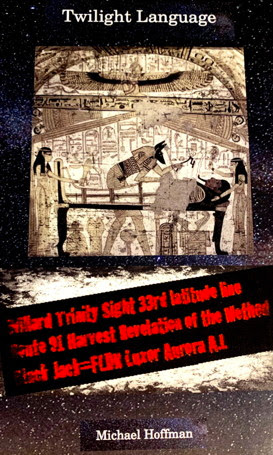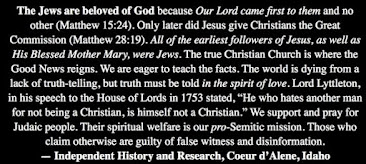Blaspheming Mary and the Birth of Jesus in the Talmud
By Michael Hoffman
Let us begin by asking about the first Christmas. Does the Talmud teach that Jesus was born the bastard son of a Roman soldier and that His mother Mary was a harlot? Or is that one of those “anti-semitic tropes” that circulate on the Internet?
We shall answer from the documentary record.
In Yiddish “Yoshke Pandre,” is an insulting name for Jesus. Concerning the denotation of the first name, strictly speaking it denotes Yoysif (Joseph), but connotatively it is a play on Jesus’s name in Hebrew, Yeshu (a diminutive of Yeshua, or in long form, Yehoshua). Our primary interest is in the patronymic “Pandre,” which is Yiddish shorthand for “Pandera,” and therein hangs our narrative.
Babylonian Talmud (BT) tractate Shabbat 104b:
“It was taught in a baraita that Rabbi Eliezer said to the Rabbis: Didn’t the infamous ben Stada take magic spells out of Egypt in a scratch on his flesh?
“They said to him: He was a fool, and you cannot cite proof from a fool. That is not the way that most people write.
“Incidentally, the Gemara asks: Why did they call him ben Stada, when he was the son of Pandeira?
“Rav Ḥisda said: His mother’s husband, who acted as his father, was named Stada, but the one who had relations with his mother and fathered him was named Pandeira.
“The Gemara asks: Wasn’t his mother’s husband Pappos ben Yehuda?
“Rather, his mother was named Stada and he was named ben Stada after her.
“The Gemara asks: But wasn’t his mother Miriam the hairdresser?
“The Gemara explains: That is not a contradiction. Rather, Stada was merely a nickname, as they say in Pumbedita: This one has been unfaithful [setat da] to her husband” (end quote BT Shabbat 104b).
In the preceding Talmud passage we encounter “ben Stada,” “Pandera” (“Pandeira”), and “Miriam the hairdresser.”
In the Babylonian Talmud, Jesus is the fool/magician, called "son of Stada" and "son of Pandera.”
The Talmud is concerned about the fact that the same person is called by two different names. Rav Hisda (a Babylonian amora of the third generation and an important teacher at the academy of Sura, who died 309 A.D.), states that the person in question had, as it were, two “fathers,” because his mother had a husband and a sex partner, and that Jesus was called ‘son of Stada,’ when referring to the husband, and ‘son of Pandera,’ when referring to the sex partner.
Shabbat 104b alternately states that Jesus’ mother's husband was not some “Stada,” but rather "Pappos b. Yehuda," (a Jewish-Palestinian scholar of the first half of the second century A.D.), and in fact it was Jesus’ mother who was called “Stada.”
We need to decrypt this code-name “Stada” for the mother of Jesus (another name for her in the Talmud is is Miriam).
“Stada” is a grave insult. Peter Schäfer, in his indispensable text, Jesus in the Talmud (Princeton University, 2007), found that “Stada” is derived from the Hebrew/Aramaic root word satah/seté (“to deviate from the right path, to go astray, to be unfaithful”).
In other words, Jesus’s mother was also termed “Stada” because in the eyes of the rabbis she was a sotah, an adulteress.
The Steinsaltz version of BT Sanhedrin 67a states: “...the inciter’s mother was Miryam the (woman’s) hairdresser...a promiscuous woman: that one (setat da) strayed from her husband.” (Steinsaltz Talmud [Random House, 1998], vol. XVIII, p. 227.)
So we have Jesus (the “inciter”) as one who “brought forth witchcraft from Egypt,” and his mother, “Miriam the hairdresser” as a promiscuous woman who had intercourse with men other than her husband.
Prof. Schäfer: “If the Talmud takes it for granted that Jesus’ mother was having sex with someone other than her husband, then it follows that Jesus was a mamzer, a bastard. In order to be categorized as mamzer it didn’t matter whether his biological father was indeed his mother’s sex partner, and not her legal husband, the supposed fact that she had committed adultery made Jesus’ legal status dubious. Hence the uncertainty, in that his father is sometimes called Ben Stada and sometimes Ben Pandera.”
The context of BT tractates Shabbat 104b and Sanhedrin 67a suggest that Mary’s supposedly long and uncovered hair (“megadla neshayya”) was indicative of her allegedly indecent behavior. In the misogynist minds of the rabbis of the Gemara, a woman who appears bareheaded and with long hair, in public, is prone to all sorts of lewd conduct (cf. BT Gittin 90a).
Of course there is no proof that Mary, the mother of Jesus, ever went about in this manner, but it indicates the resentment the rabbis experienced in the face of the liberty Jesus dispensed to His female followers. Describing his mother as allegedly going about without a head-covering—which remains a Talmudic requirement for many frum (“observant”) female followers of the rabbinic traditions to this day —is one expression of that resentment.
Rabbi Adin Steinsaltz, the one-time nasi of the revived Sanhderin, attempts to deny the Jesus/Pandera links:
“Christian censors as well as popular tradition identified ‘ben Setada’ and ‘ben Pandera’ with Jesus of Nazareth because of the similarity of several aspects of the two stories. However, Tosafot regarded this identification as impossible because of the chronology” (Steinsaltz’s pilpul is elaborated in a margin note to Shabbat 104b in the Koren edition of the Steinsaltz Talmud: Koren Talmud Bavli [Jerusalem, 2012], vol. 3, p. 120).
Talmudic apologists assert that the Babylonian Talmud’s “Pandera” is a reference to the father of another ancient Jesus, not Jesus of Nazareth. They also allege that the name Pandera is a common one in Latin i.e. “gentile” inscriptions from the period, which is true. But, as Prof. Schäfer points out, the name Panthera/Pandera is highly uncommon in Hebrew and Aramaic usage, “and this fact alone makes the connection to Celsus’ Panthera obvious”).
Prof. Schäfer alludes to the independent evidence of the existence of the Jesus-Pandera teaching in Judaism, in the writings of Celsus, the second century A.D. pagan opponent of Christianity, who attacked it by quoting the calumnies of the rabbis which were current in his lifetime. Celsus's tract, Alethes Logos (“True Word”), repeats the libels cast on Jesus and Mary by the proto-Talmudic rabbinate:
“Celsus opens the way for his own attack by rehearsing the taunts leveled at the Christians by the Jews. They are: Jesus was born in adultery and nurtured on the wisdom of Egypt.” (Encyclopædia Britannica, eleventh edition (1910–1911), “Celsus.”)
Celsus’ works are lost, but we know of him through his third century Christian challenger, Origen, who quoted him at length in Contra Celsum (“Against Celsus”).
Origen relates that Celsus deployed the teachings of the rabbis concerning Jesus, in his campaign against Christianity, in the form of a Jew about whom Celsus inquires concerning what this Jew may know about Jesus.
The Jew replies: “...he (Jesus) came from a Jewish village and from a poor country woman who was driven out by her husband, who was a carpenter by trade, since she had been convicted of adultery. After she had been driven out by her husband and while she was wandering about in a disgraceful manner, she secretly gave birth to Jesus. Because he (Jesus) was poor, he hired himself out as a workman in Egypt, and there tried his hand at certain magical powers on which the Egyptians pride themselves; he returned full of conceit, because of these powers, and on account of them gave himself the title of God.” (Origen, Contra Celsus, Book I, ch. 28).
Writing in 178 A.D., Celsus the pagan antagonist of the Christians, had reiterated precisely the insults toward Jesus and Mary that would be committed to writing in the Babylonian Talmud a few hundred years later.
Origen analyzes the statement which the Jewish informant conveyed to Celsus:
“Let us now return to where the Jew is introduced, speaking of the mother of Jesus, and saying that ‘when she was pregnant she was turned out of doors by the carpenter to whom she had been betrothed, as having been guilty of adultery, and that she bore a child to a certain (Roman) soldier named Panthera...those who have blindly concocted these fables about the adultery of the Virgin with Panthera...on account of its extremely miraculous character...It was to be expected, surely, that those who would not believe the miraculous birth of Jesus would invent some falsehood.” (Origen, Contra Celsus, Book I, ch. 32).
As Origen reports, Celsus’s Jewish informant might as well have been quoting from a volume of the Talmud turned to Gittin 90a and Shabbath 104b. However, as noted, these calumnies would not be committed to writing in Talmud tractates for another few hundred years. This fact indicates that these malicious lies about Jesus, His mother and His patrimony, were well-established dogma in Judaism as early as 178 A.D. They were subsequently and formally institutionalized in the holiest books of Judaism. “It is certain, in any case, that the rabbinical sources also regard Jesus as the ‘son of Pandera.” (Jewish Encyclopedia, v. 6, p. 170 [NY: Funk and Wagnalls, 1912; also cf. BT Hullin 2:22 and 2:24.
Truth from the documentary record is not “anti-semitic.”
Truth cannot be “anti” anyone.
The truth sets all people—be they Jew or goy—free.
Jesus was Himself a Semite. The defense of His holy name and that of His semitic mother is a pro-Semitic act. This would be plain to see were it not for the fear of the ADL and other thought police instilled in academics, journalists and owners of social media.
Whatever the cost, it is a signal privilege to defend from calumny Our Lord Jesus Christ and His Blessed Virgin Mother at Christmas 2019.
— Michael Hoffman
Michael is a student of the Talmud Bavli and cognate rabbinic writings. He is the author of the textbook, Judaism Discovered (2008), and a condensed edition for the general public, Judaism’s Strange Gods: Revised and Expanded (2010). His Judaica studies continue in the periodical, Revisionist History.
After pressure from the ADL, in August of 2019 YouTube canceled his account and banned all of his videotaped lectures. Michael’s research and writing continues to be made possible through the sale of his books, newsletters, audio and video recordings and donations from truth-seekers.
Copyright©2019 by Independent History and Research
Box 849, Coeur d’Alene, Idaho 83816 USA
_______________














No comments:
Post a Comment